|
_______________________________________
Crystal Idioblasts
Plant cells that create microscopic crystals
_____________________________________
| Currently my research interests focus on plant
cells that produce crystals of calcium oxalate. I am particularly interested in plants
of the Arum family, and do most of my work on the common -- and poisonous --
houseplant, Dieffenbachia (right). This plant, and
some of its aroid relatives has crystals that can be actively shot out of
the cell, presumably into the mouth tissues of anything eating it. A
picture of one of these ballistic cells is shown below. Note
the nipples at either end where the cell wall is weak and can
be ruptured to allow crystals to be shot out. This cell is
called a biforine. |
|
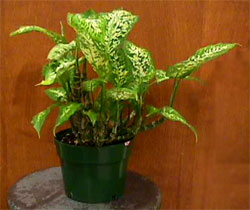 |
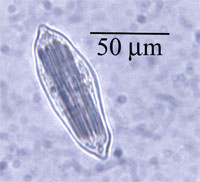 |
|
Dieffenbachia and its fellow aroids also contain many
other kinds of cells that make crystals (called crystal idioblasts
--"idioblast" means "different cell"). A few other kinds of
crystal idioblasts are shown below. The
flower-like ones are druses and the other is a bundle of
raphides. Why do plants make
these crystals? The most popular theory is that they make them to discourage animals from eating them,
but maybe they provide structural support or a place to store
calcium. Why do plants make so many kinds of crystals? Right
now, nobody knows. |
| In my lab we use bright-field, fluorescent, and polarization
microscopy to study crystal idioblasts. The pictures at right
were taken with polarization microscopy, which is particularly
useful for studying crystals. Below is shown a biforine photographed
under polarization microscopy. |
|
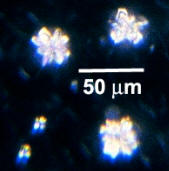 |
|
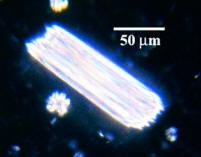 |
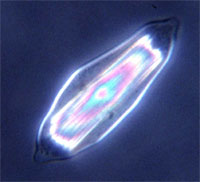 |
|
We have worked out methods for isolating live idioblasts from
leaves so that we can study these peculiar cells (below, Jeremy
Hensley and Raymond Hein are preparing a large batch of idioblast
cells). We are using the tools of biochemistry to study these
cells and how they are different from other plant cells. We are
also studying crystal idioblasts in the flowers of Dieffenbachia's
aroid relatives. Although crystals have been thoroughly
documented in the leaves of hundreds of species, relatively little
is known about crystals in the flowers. |
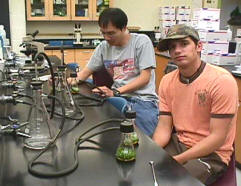 |
|
Are you a student interested in
research on crystal idioblasts? Come talk to me. Every student in biology should become involved in
true scientific research at some point in their education. |
|



